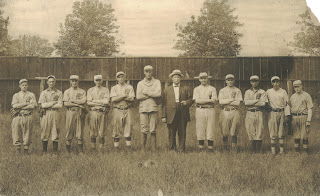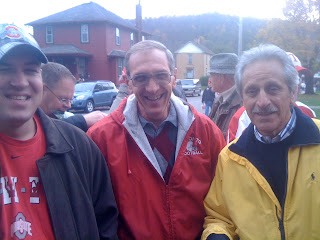THE HANGING HEAD OF CAMP CRUMB
The
name is forgotten, maybe because those who remember simply want to forget.
But
the memory lingers like a child’s nightmare, the repressed one deep in the seat
of the subconscious, this one deep in the woods outside Toronto, taking one
deep in time, back to Camp Crumb, where time seems to cease and the human
psyche surrenders to fear.
The
tale of the Hanging Tree and its vile fruit the Hanging Head has been passed on
from generation to generation until now it looms high with other urban
legends. Is it truly legend, a
myth worthy of the lunatic with the prosthetic hook, or just another haunted
forest yarn to scare schoolboys on pitch dark, campfire nights?
As
the legend goes, a distraught man hanged himself near the cliffs at Camp Crumb sometime
during the 1930s. Camp Crumb is
situated a quarter-mile up Sloane’s Run along the northeastern base of Wallace
Hill. During the latter decade of
the 19th century and the first decade of the 20th, it was
a popular site for picnics and other outdoor excursions. Hundreds of initials tattooed into the
bald gray beech trees still attest to this day how popular Camp Crumb once was.
These
ancient gray trees cast gentle shadows upon a terrace tasseled with ferns and
sitting-sized sandstones velveted with moss at a site during the day Zen-like,
a setting tranquil enough to meditate.
But after the sun goes down…
“That’s where a man hanged himself,” said
Dick Walker, who has lived all his 50-plus years in Toronto. “My mother and some old-timers told me
how the man hanged himself with a chain at Camp Crumb and that he remained
missing for two weeks until his dog dragged his hand home. When the search party finally arrived
at Camp Crumb all they found was the man’s head swinging from a chain wrapped
around a limb of a beach tree near a cliff.”
His late mother told Walker the hanged
man’s name, but he can only remember the gruesome details and that the man
worked for Mike Henry probably during the 1930s at the White Front Café.
“I heard too many people talk about the Hanging
Tree to pass it off as some campfire tale,” Walker said. “Besides, something is weird up there
at night. Just makes your skin crawl. Me and five other guys tried camping out there overnight when
we were young, but it was just too spooky. Plenty of other guys have tried sleeping out up Camp Crumb,
too, and nobody can claim he made it to daylight.”
“I remember one night like it was yesterday,”
said Pat Daughtery about the adventure he shared with Walker at Camp
Crumb. “There were six of us
laughing up a storm, telling stories when suddenly we heard a chain clanging
high in the beech trees. We took
off so fast we forgot to pick up our beer.”
“We called it the Hanging Tree,” said Joe
Nemitt Sr. recalling boyhood excursions predating Walker’s by two decades to
the tragic site. We got scared
quickly and didn’t stick around long.”
“I wouldn’t camp out there with 50 guys
and two kegs and a bucket of holy water,” added Daughtery, “and I bet no one
else would last there more than a couple of hours.”
Exactly where this desperate deed
occurred is a matter of speculation these days, says J.L. Minor a former deputy
sheriff for Colliers County, Florida, now returned to the Ohio Valley, bringing
home his passions that include paranormal arboreal phenomena and
crptozoology.
“You have to remember that trees in a
forest tend to grow a few stories high before branching out,” Minor said. “So the branch from which he hanged
himself probably jutted from a tree ten to 15 feet above some kind of platform
from which he could have jumped off.
Such a tree would now be around 85 years old today and much too high to
determine where a chain or rope once hung.”
The American beech, according to Wikipedia, averages 150 to 200 years of
age and can live up to 300 years in ideal habitat. These trees reach maturity around 40 years of age and can
attain heights of around 100 feet.
The beech, also according to another
electronic web site, The Masonic Druid,
was the most used tree for lynching and ritualistic sacrifices during the 1700s
and 1800s in the United States, the limbs valued for their pliability, the tree
for its purgative power.
From Google
Earth, if one knows where to look, the latitude and longitude coordinates
can be found to locate the lost forest camp, on the map, that is, but on foot
one’s cell phone service seems to vaporize mysteriously in the mist.
Why the victim chose Camp Crumb as the
site for self-destruction is another matter of speculation. The camp had fallen into disuse for
about a quarter-century when he committed the desperate deed. Perhaps some tragic event predates his
hanging and left an evil energy summoning the distraught and the
desperate. And, indeed, there are
tales of unholy rituals, whispered, from those who seek the refuge of
anonymity, but it is best to leave these tales untold and buried deep beneath
the cryptic dark shadows of the forest.
CAMP CRUMB
It’s called Camp
Crumb
Because
everything falls
Apart like the
dude
That hanged
himself.
Limb by limb by
Limb fell to
fertilize
The forest floor
Until all that
remained
Was his head, a
trophy
Defying gravity,
Defying the
senses until it
Fell to decay,
rotting
Into an unholy
fruit,
A stagnant
weight
upon a rusty
chain.
It still holds,
sways
In the windless
rustic night,
Clangs-clangs
like a train
Steaming from
Hell,
Pulling up to
Scaffold Rock
To offer passage
From a platform
Where everything
falls
Apart—your
senses, your sanity,
Even your soul.
ORIGINS, GEM CITY
So you think
this is your town?
Call it Gem
City,
Have been
calling it Gem City so long
You don’t even
know why
You call it Gem
City,
Just take it for
granted
Like on the
corner of Grant Street
Those little
noises, tweaks, bumps-in-the-night
At the old
Melhorns building
At times
strolling by old Harry Goucher,
Lost, looking
for his home, you know,
The one no
longer on River Avenue.
He doesn’t feel
at home in the grave,
Either, up in
Union Cemetery, absent
With a few other
absentees
Like Suzanne
Daniels, a centenarian
Formerly of the
living some 90 years ago
So formal in
place-setting her tables,
She’ll rearrange
your forks, spoons and sanity
For you with an
unexpected appearance
Here and there
in her building.
Then there’s that
John Doe
You call the
Hanging Head of Camp Crumb,
He was
distraught, all right,
Found out he married the wrong woman,
Turned out his
black-hearted half-sister,
So he took the
eternal plunge
Right off
Scaffold Rock, keeps
Sentry up there
high in the trees
Whistling trespass
alarm through
The hollows of
his eyes.
These common
folks had so much in common,
My descendents
who descended
Through my dark
side.
Some call me patriarch,
some usurper,
Me, who bathed
in Chief Logan’s baby’s blood
At Yellow Creek,
me, who lived to be 107;
So strange,
don’t you think,
Even for strange
folks like you,
You whose sires
I sired so so long ago,
Me, Auver
Michael Myers, the “great”grandsire
Cousins,
kiss-of-death cousins—
Who shall live a
long long time,
If you can call
ghosting living;
Such glowing
examples of kin you are,
Even for inbred
hybrids.
Shine shine
shine on,
All my little
gems.
September
1781, It was a scene worth of a Hollywood plot: Andrew Poe and Wyandot Chief Bigfoot combating along the meanering
stream of Tomlinson Run with riffles and tomahawks and continuing their
struggle into the Ohio River where they were reduced to the savagery of
bare-hand combat where the half-foot taller Virginian. Wading waist deep,
finally gave the Wyandot subchief a fatal baptism.
Witnesses
stated that before his brother Adam could reach them with his scalping tools,
Chief Bigfoot slipped away on the surface, rolled over and howled in pain and
hate before the blue-gray currents claimed him and swept him away to his
ancestral sky lands.
Some
claim his final utterings were a curse, the dark tone of hatred in any language
unmistakable. Whether the curse
theory is merely conjecture, there is some evidence to give credence to truth
in it for drownings followed there by an unholy dozen.
The
first recorded drewning occurred April 12, 1912 when four young Port Homer men
returning from a prayer meeting across river from Wesely Chapel in a john boat
capsized, spilling Harry Brant, 20, and brother Earl, 18, along with Hugh
Sproul, 18, and Clifford Howard, 17.
All four drowned. A fifth
passenger, J. Crosley, managed to desperately cling to the upturned craft until
rescued.
According
to Crosly, during the boys’ return trip, they were rowing smoothly across the
river, reached midstream, when for no apparent reason the boat overturned,
spilling the crew of five into the swift spring currents of the Ohio River.
It
should be pointed out the Ohio River was much shallower and less wide at that
period and that the navigational structure Dam Number 9 just south of Empire was currently under
construction.
The
new dam when finished did slow the big blue stream some and widened it and then
in 1960 the completion of a yet more modern structure, the New Cumberland Locks
and Dam, made the water upstream deeper, almost lake-like, at times
current-less, but not less dangerous.
Still the drownings happened at Port Homer, including one of a
recreational boater in the chamber itself in the early 1980s and another on
april 6, 2009 when 26-year-old Michael Harvey, a deckhand for Campbell Towing Company, fell off a barge and
drowned in harvor of the W.H. Sammis Plant’s harbor at Port Homer.
The
Sammis Plant harbor, incidentally, has also been a collectio point for victims
drowning upstream, in colloquial river talk called “floaters,” three of which
found their final passage downstream directl across te site of the deadly
dunking of Chief Big Foot.
Perhaps
even outside the Ohio River did the Wyandot’s curse carry because in April
1935, a 12-year-old boy fishing in the lake used by Stratton Clay for
industrial water slipped in and drowned, the accident occurring less than a
mile from BigFoot’s watery grave, and what a quarter-century later would become
the site of the New Cumberland Locks and Dam where two workers fell and drowned
during its construction.
Coincidence
or curse-induced? We will never
know for sure, but a tally of 11 have found a watery demise within a one-mile
distance of one another, and counting the first victim, the Wyandot subchief, a
total of an unholy dozen, giving credence to the title “Port Homer—the Bermuda
Triangle of the Ohio Valley.”











































